Report on UK Homelessness: Causes, Prevention Strategies & Legislation
VerifiedAdded on 2023/06/15
|13
|2779
|213
Report
AI Summary
This report identifies the major causes behind homelessness in the UK, including personal factors like lack of qualifications, debt, and family issues, as well as structural factors such as unemployment, lack of affordable housing, and housing policies. It also examines the specific reasons for youth homelessness, such as family breakdown, complex needs, deprivation, gang crime, and exclusion from school. Factors that trigger homelessness, like divorce, domestic violence, illness, and lack of public assistance, are also discussed. The report concludes that addressing homelessness requires a collaborative effort between the government and the public, with prevention strategies including legislation and support services in both North Ireland and England. Desklib provides access to similar reports and study resources for students.

Running head: HOUSING MANAGEMENT AND PRACTICE
Housing Management And Practice
Name of the Student
Name of the University
Author note
Housing Management And Practice
Name of the Student
Name of the University
Author note
Paraphrase This Document
Need a fresh take? Get an instant paraphrase of this document with our AI Paraphraser
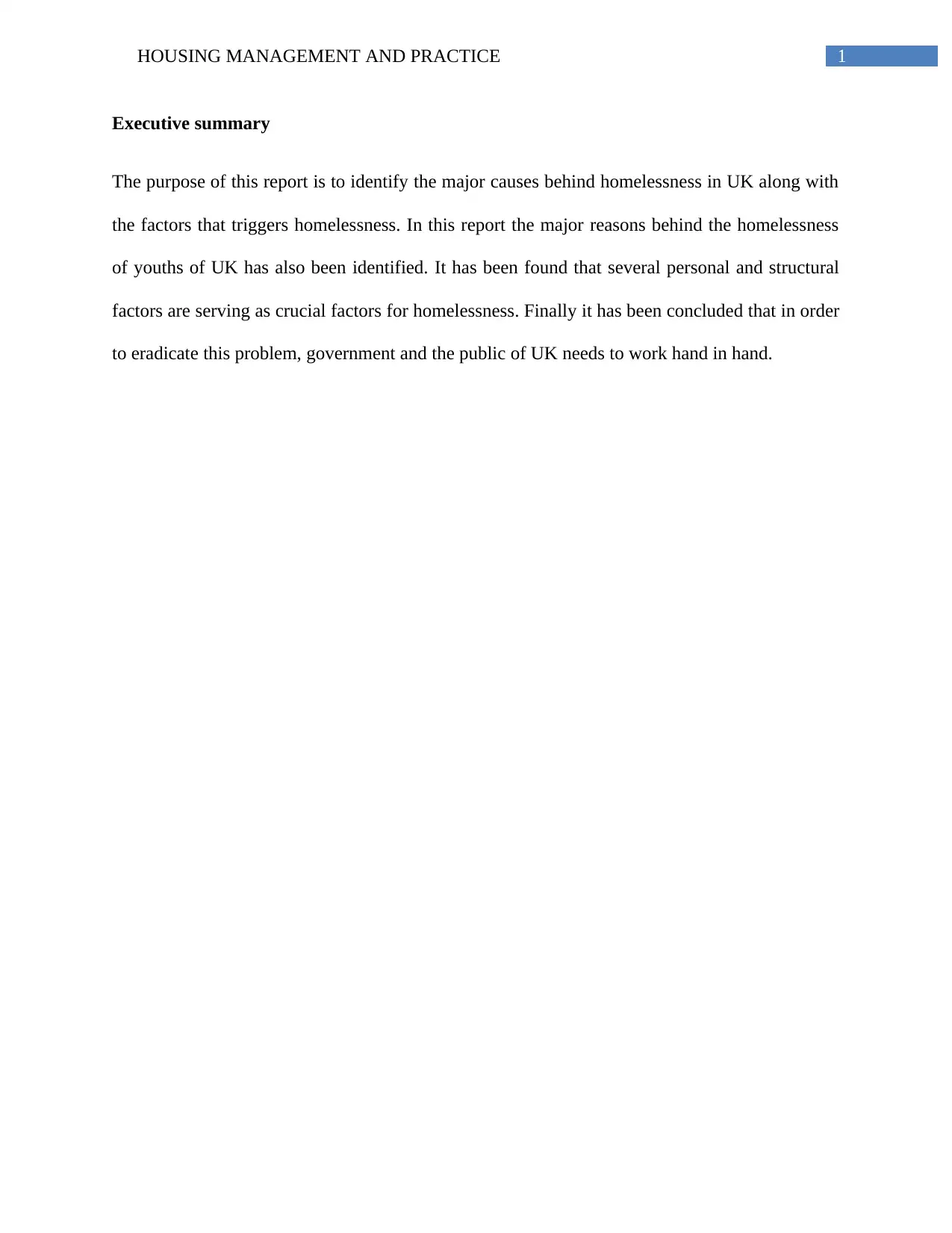
1HOUSING MANAGEMENT AND PRACTICE
Executive summary
The purpose of this report is to identify the major causes behind homelessness in UK along with
the factors that triggers homelessness. In this report the major reasons behind the homelessness
of youths of UK has also been identified. It has been found that several personal and structural
factors are serving as crucial factors for homelessness. Finally it has been concluded that in order
to eradicate this problem, government and the public of UK needs to work hand in hand.
Executive summary
The purpose of this report is to identify the major causes behind homelessness in UK along with
the factors that triggers homelessness. In this report the major reasons behind the homelessness
of youths of UK has also been identified. It has been found that several personal and structural
factors are serving as crucial factors for homelessness. Finally it has been concluded that in order
to eradicate this problem, government and the public of UK needs to work hand in hand.
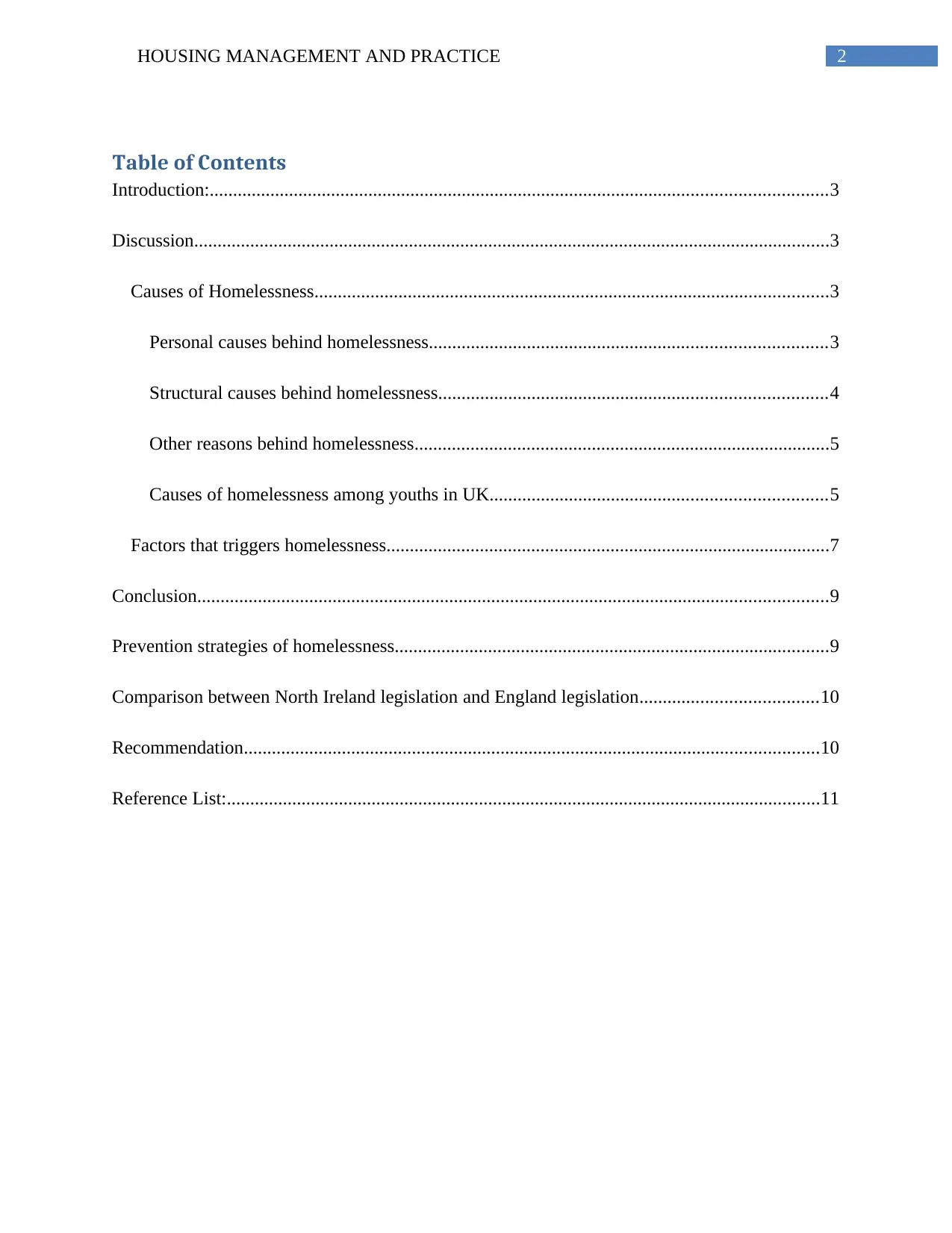
2HOUSING MANAGEMENT AND PRACTICE
Table of Contents
Introduction:....................................................................................................................................3
Discussion........................................................................................................................................3
Causes of Homelessness..............................................................................................................3
Personal causes behind homelessness.....................................................................................3
Structural causes behind homelessness...................................................................................4
Other reasons behind homelessness.........................................................................................5
Causes of homelessness among youths in UK........................................................................5
Factors that triggers homelessness...............................................................................................7
Conclusion.......................................................................................................................................9
Prevention strategies of homelessness.............................................................................................9
Comparison between North Ireland legislation and England legislation......................................10
Recommendation...........................................................................................................................10
Reference List:...............................................................................................................................11
Table of Contents
Introduction:....................................................................................................................................3
Discussion........................................................................................................................................3
Causes of Homelessness..............................................................................................................3
Personal causes behind homelessness.....................................................................................3
Structural causes behind homelessness...................................................................................4
Other reasons behind homelessness.........................................................................................5
Causes of homelessness among youths in UK........................................................................5
Factors that triggers homelessness...............................................................................................7
Conclusion.......................................................................................................................................9
Prevention strategies of homelessness.............................................................................................9
Comparison between North Ireland legislation and England legislation......................................10
Recommendation...........................................................................................................................10
Reference List:...............................................................................................................................11
⊘ This is a preview!⊘
Do you want full access?
Subscribe today to unlock all pages.

Trusted by 1+ million students worldwide
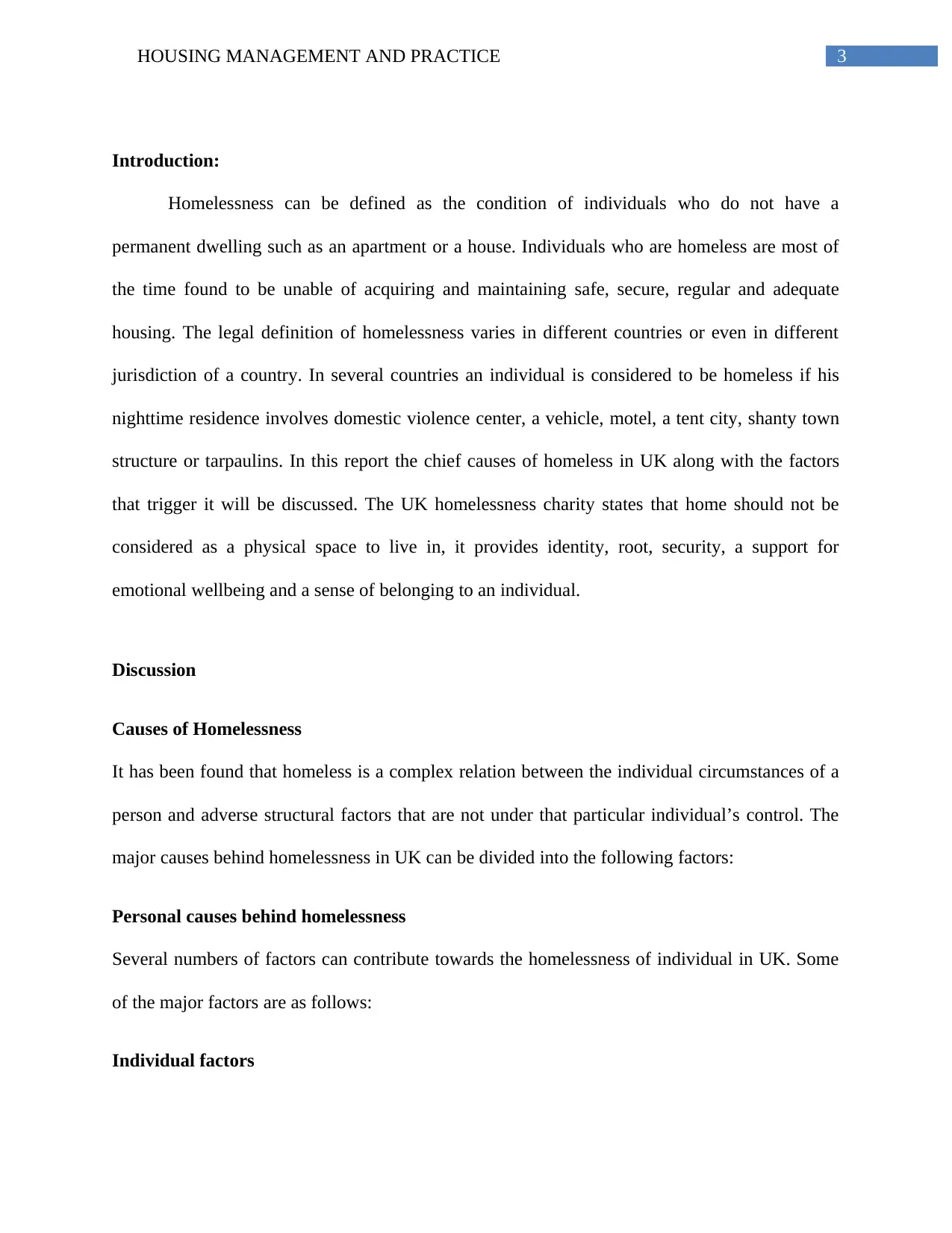
3HOUSING MANAGEMENT AND PRACTICE
Introduction:
Homelessness can be defined as the condition of individuals who do not have a
permanent dwelling such as an apartment or a house. Individuals who are homeless are most of
the time found to be unable of acquiring and maintaining safe, secure, regular and adequate
housing. The legal definition of homelessness varies in different countries or even in different
jurisdiction of a country. In several countries an individual is considered to be homeless if his
nighttime residence involves domestic violence center, a vehicle, motel, a tent city, shanty town
structure or tarpaulins. In this report the chief causes of homeless in UK along with the factors
that trigger it will be discussed. The UK homelessness charity states that home should not be
considered as a physical space to live in, it provides identity, root, security, a support for
emotional wellbeing and a sense of belonging to an individual.
Discussion
Causes of Homelessness
It has been found that homeless is a complex relation between the individual circumstances of a
person and adverse structural factors that are not under that particular individual’s control. The
major causes behind homelessness in UK can be divided into the following factors:
Personal causes behind homelessness
Several numbers of factors can contribute towards the homelessness of individual in UK. Some
of the major factors are as follows:
Individual factors
Introduction:
Homelessness can be defined as the condition of individuals who do not have a
permanent dwelling such as an apartment or a house. Individuals who are homeless are most of
the time found to be unable of acquiring and maintaining safe, secure, regular and adequate
housing. The legal definition of homelessness varies in different countries or even in different
jurisdiction of a country. In several countries an individual is considered to be homeless if his
nighttime residence involves domestic violence center, a vehicle, motel, a tent city, shanty town
structure or tarpaulins. In this report the chief causes of homeless in UK along with the factors
that trigger it will be discussed. The UK homelessness charity states that home should not be
considered as a physical space to live in, it provides identity, root, security, a support for
emotional wellbeing and a sense of belonging to an individual.
Discussion
Causes of Homelessness
It has been found that homeless is a complex relation between the individual circumstances of a
person and adverse structural factors that are not under that particular individual’s control. The
major causes behind homelessness in UK can be divided into the following factors:
Personal causes behind homelessness
Several numbers of factors can contribute towards the homelessness of individual in UK. Some
of the major factors are as follows:
Individual factors
Paraphrase This Document
Need a fresh take? Get an instant paraphrase of this document with our AI Paraphraser
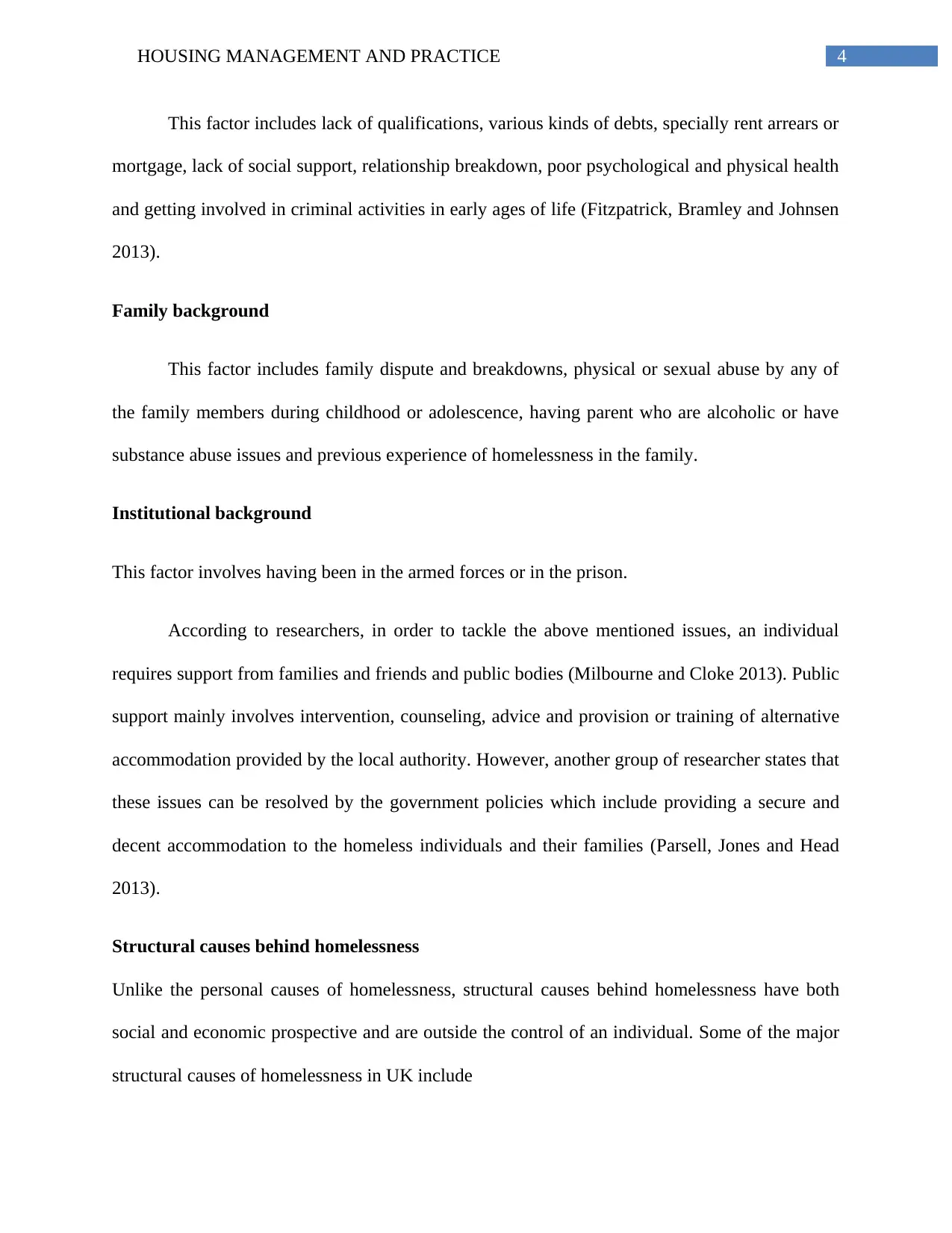
4HOUSING MANAGEMENT AND PRACTICE
This factor includes lack of qualifications, various kinds of debts, specially rent arrears or
mortgage, lack of social support, relationship breakdown, poor psychological and physical health
and getting involved in criminal activities in early ages of life (Fitzpatrick, Bramley and Johnsen
2013).
Family background
This factor includes family dispute and breakdowns, physical or sexual abuse by any of
the family members during childhood or adolescence, having parent who are alcoholic or have
substance abuse issues and previous experience of homelessness in the family.
Institutional background
This factor involves having been in the armed forces or in the prison.
According to researchers, in order to tackle the above mentioned issues, an individual
requires support from families and friends and public bodies (Milbourne and Cloke 2013). Public
support mainly involves intervention, counseling, advice and provision or training of alternative
accommodation provided by the local authority. However, another group of researcher states that
these issues can be resolved by the government policies which include providing a secure and
decent accommodation to the homeless individuals and their families (Parsell, Jones and Head
2013).
Structural causes behind homelessness
Unlike the personal causes of homelessness, structural causes behind homelessness have both
social and economic prospective and are outside the control of an individual. Some of the major
structural causes of homelessness in UK include
This factor includes lack of qualifications, various kinds of debts, specially rent arrears or
mortgage, lack of social support, relationship breakdown, poor psychological and physical health
and getting involved in criminal activities in early ages of life (Fitzpatrick, Bramley and Johnsen
2013).
Family background
This factor includes family dispute and breakdowns, physical or sexual abuse by any of
the family members during childhood or adolescence, having parent who are alcoholic or have
substance abuse issues and previous experience of homelessness in the family.
Institutional background
This factor involves having been in the armed forces or in the prison.
According to researchers, in order to tackle the above mentioned issues, an individual
requires support from families and friends and public bodies (Milbourne and Cloke 2013). Public
support mainly involves intervention, counseling, advice and provision or training of alternative
accommodation provided by the local authority. However, another group of researcher states that
these issues can be resolved by the government policies which include providing a secure and
decent accommodation to the homeless individuals and their families (Parsell, Jones and Head
2013).
Structural causes behind homelessness
Unlike the personal causes of homelessness, structural causes behind homelessness have both
social and economic prospective and are outside the control of an individual. Some of the major
structural causes of homelessness in UK include
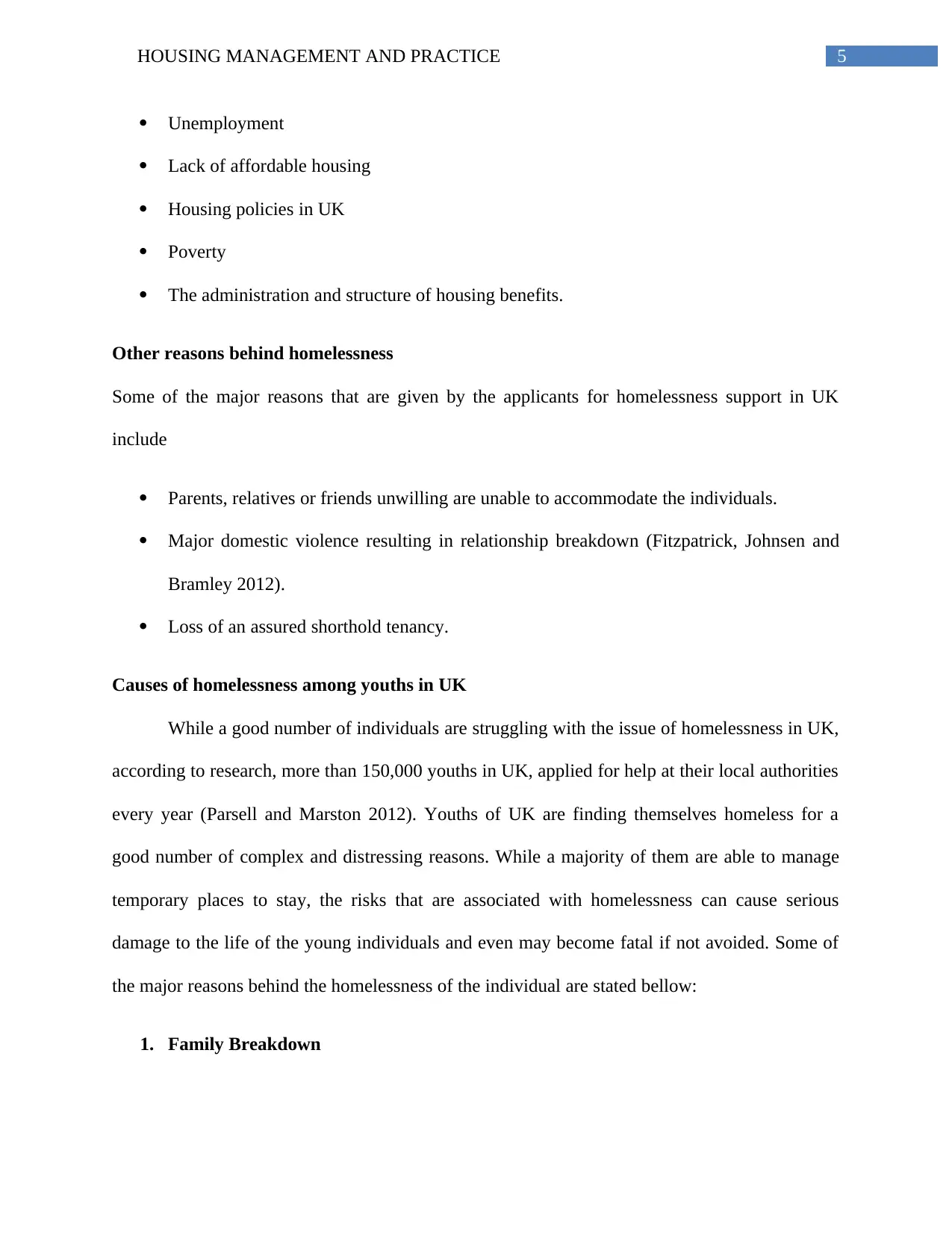
5HOUSING MANAGEMENT AND PRACTICE
Unemployment
Lack of affordable housing
Housing policies in UK
Poverty
The administration and structure of housing benefits.
Other reasons behind homelessness
Some of the major reasons that are given by the applicants for homelessness support in UK
include
Parents, relatives or friends unwilling are unable to accommodate the individuals.
Major domestic violence resulting in relationship breakdown (Fitzpatrick, Johnsen and
Bramley 2012).
Loss of an assured shorthold tenancy.
Causes of homelessness among youths in UK
While a good number of individuals are struggling with the issue of homelessness in UK,
according to research, more than 150,000 youths in UK, applied for help at their local authorities
every year (Parsell and Marston 2012). Youths of UK are finding themselves homeless for a
good number of complex and distressing reasons. While a majority of them are able to manage
temporary places to stay, the risks that are associated with homelessness can cause serious
damage to the life of the young individuals and even may become fatal if not avoided. Some of
the major reasons behind the homelessness of the individual are stated bellow:
1. Family Breakdown
Unemployment
Lack of affordable housing
Housing policies in UK
Poverty
The administration and structure of housing benefits.
Other reasons behind homelessness
Some of the major reasons that are given by the applicants for homelessness support in UK
include
Parents, relatives or friends unwilling are unable to accommodate the individuals.
Major domestic violence resulting in relationship breakdown (Fitzpatrick, Johnsen and
Bramley 2012).
Loss of an assured shorthold tenancy.
Causes of homelessness among youths in UK
While a good number of individuals are struggling with the issue of homelessness in UK,
according to research, more than 150,000 youths in UK, applied for help at their local authorities
every year (Parsell and Marston 2012). Youths of UK are finding themselves homeless for a
good number of complex and distressing reasons. While a majority of them are able to manage
temporary places to stay, the risks that are associated with homelessness can cause serious
damage to the life of the young individuals and even may become fatal if not avoided. Some of
the major reasons behind the homelessness of the individual are stated bellow:
1. Family Breakdown
⊘ This is a preview!⊘
Do you want full access?
Subscribe today to unlock all pages.

Trusted by 1+ million students worldwide
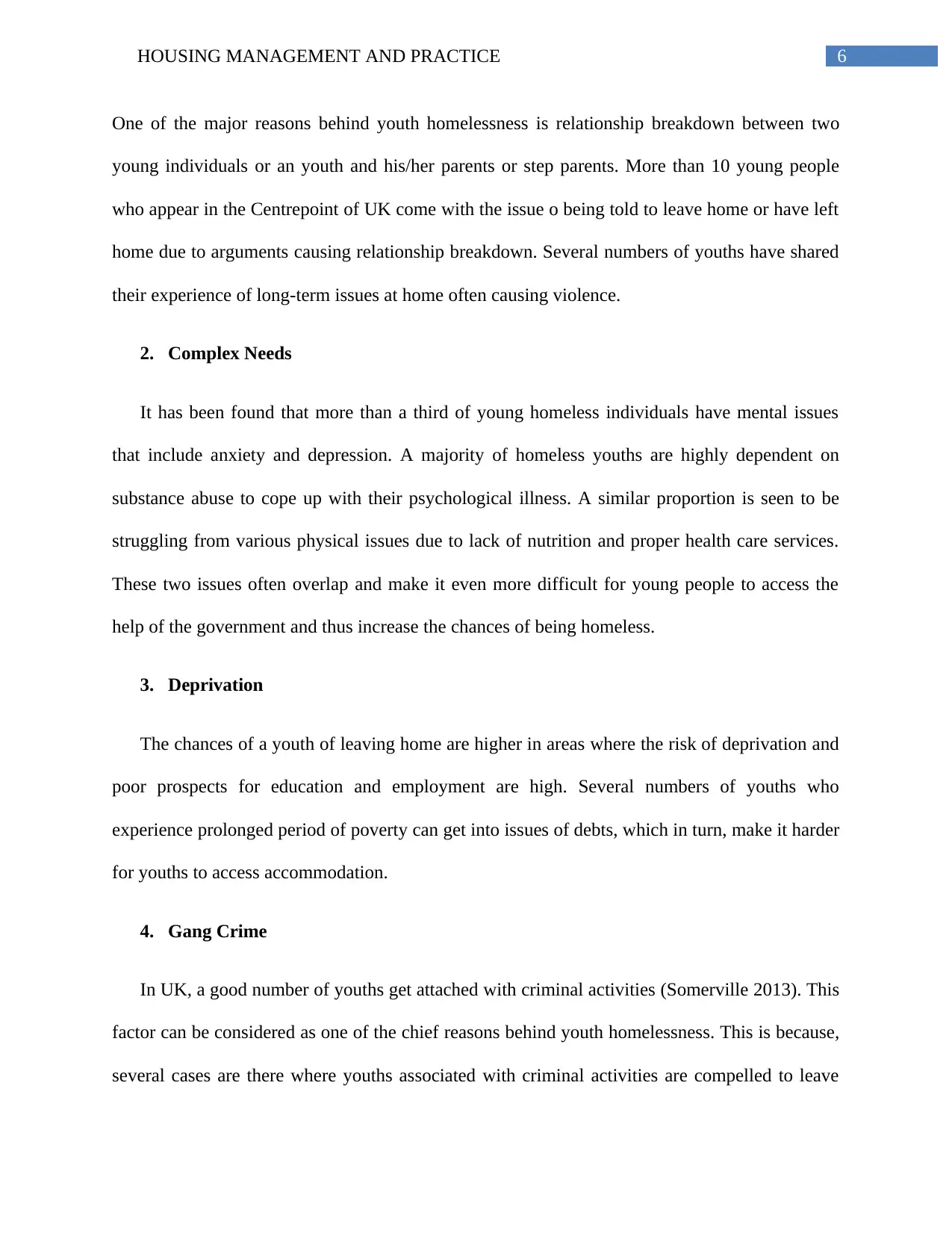
6HOUSING MANAGEMENT AND PRACTICE
One of the major reasons behind youth homelessness is relationship breakdown between two
young individuals or an youth and his/her parents or step parents. More than 10 young people
who appear in the Centrepoint of UK come with the issue o being told to leave home or have left
home due to arguments causing relationship breakdown. Several numbers of youths have shared
their experience of long-term issues at home often causing violence.
2. Complex Needs
It has been found that more than a third of young homeless individuals have mental issues
that include anxiety and depression. A majority of homeless youths are highly dependent on
substance abuse to cope up with their psychological illness. A similar proportion is seen to be
struggling from various physical issues due to lack of nutrition and proper health care services.
These two issues often overlap and make it even more difficult for young people to access the
help of the government and thus increase the chances of being homeless.
3. Deprivation
The chances of a youth of leaving home are higher in areas where the risk of deprivation and
poor prospects for education and employment are high. Several numbers of youths who
experience prolonged period of poverty can get into issues of debts, which in turn, make it harder
for youths to access accommodation.
4. Gang Crime
In UK, a good number of youths get attached with criminal activities (Somerville 2013). This
factor can be considered as one of the chief reasons behind youth homelessness. This is because,
several cases are there where youths associated with criminal activities are compelled to leave
One of the major reasons behind youth homelessness is relationship breakdown between two
young individuals or an youth and his/her parents or step parents. More than 10 young people
who appear in the Centrepoint of UK come with the issue o being told to leave home or have left
home due to arguments causing relationship breakdown. Several numbers of youths have shared
their experience of long-term issues at home often causing violence.
2. Complex Needs
It has been found that more than a third of young homeless individuals have mental issues
that include anxiety and depression. A majority of homeless youths are highly dependent on
substance abuse to cope up with their psychological illness. A similar proportion is seen to be
struggling from various physical issues due to lack of nutrition and proper health care services.
These two issues often overlap and make it even more difficult for young people to access the
help of the government and thus increase the chances of being homeless.
3. Deprivation
The chances of a youth of leaving home are higher in areas where the risk of deprivation and
poor prospects for education and employment are high. Several numbers of youths who
experience prolonged period of poverty can get into issues of debts, which in turn, make it harder
for youths to access accommodation.
4. Gang Crime
In UK, a good number of youths get attached with criminal activities (Somerville 2013). This
factor can be considered as one of the chief reasons behind youth homelessness. This is because,
several cases are there where youths associated with criminal activities are compelled to leave
Paraphrase This Document
Need a fresh take? Get an instant paraphrase of this document with our AI Paraphraser
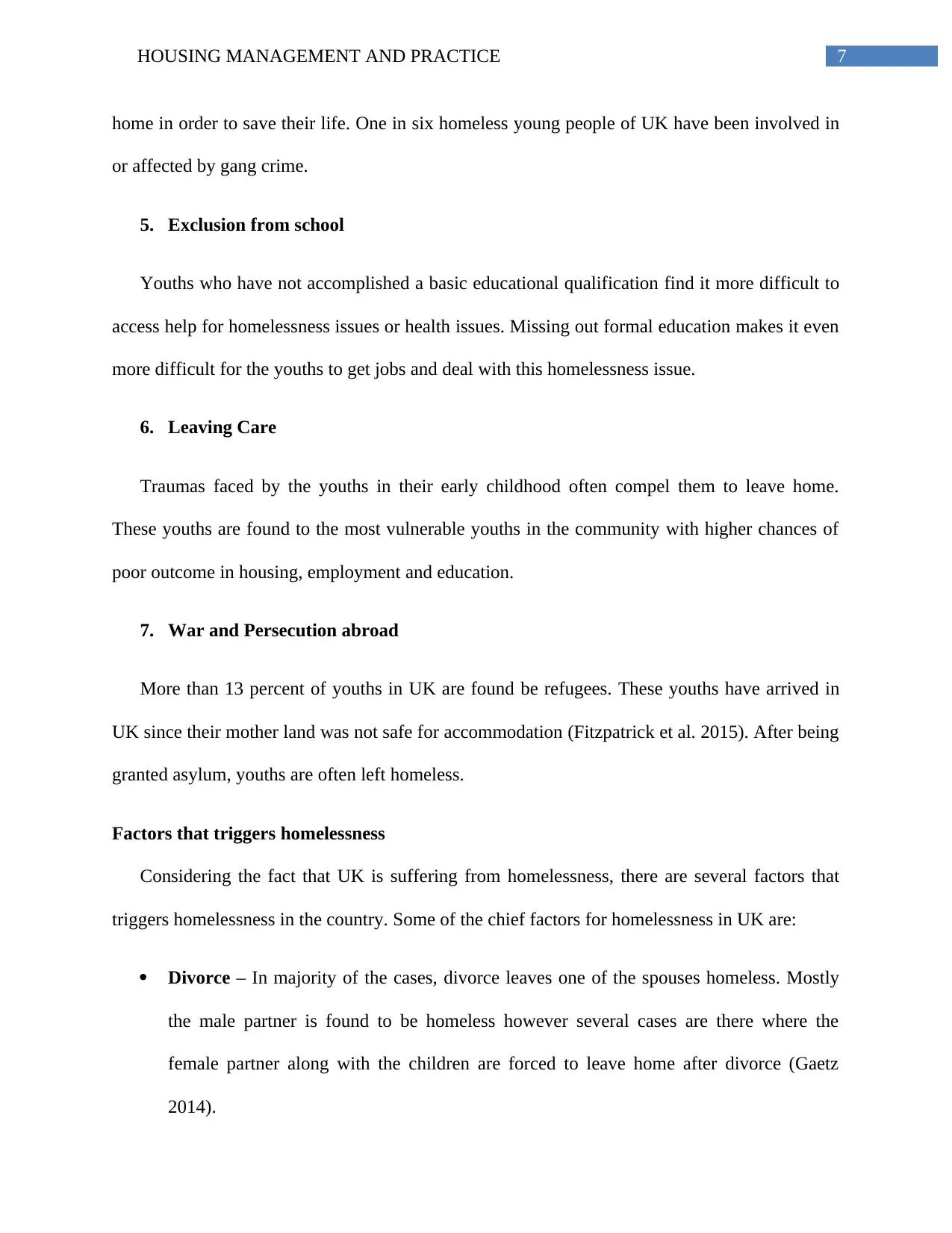
7HOUSING MANAGEMENT AND PRACTICE
home in order to save their life. One in six homeless young people of UK have been involved in
or affected by gang crime.
5. Exclusion from school
Youths who have not accomplished a basic educational qualification find it more difficult to
access help for homelessness issues or health issues. Missing out formal education makes it even
more difficult for the youths to get jobs and deal with this homelessness issue.
6. Leaving Care
Traumas faced by the youths in their early childhood often compel them to leave home.
These youths are found to the most vulnerable youths in the community with higher chances of
poor outcome in housing, employment and education.
7. War and Persecution abroad
More than 13 percent of youths in UK are found be refugees. These youths have arrived in
UK since their mother land was not safe for accommodation (Fitzpatrick et al. 2015). After being
granted asylum, youths are often left homeless.
Factors that triggers homelessness
Considering the fact that UK is suffering from homelessness, there are several factors that
triggers homelessness in the country. Some of the chief factors for homelessness in UK are:
Divorce – In majority of the cases, divorce leaves one of the spouses homeless. Mostly
the male partner is found to be homeless however several cases are there where the
female partner along with the children are forced to leave home after divorce (Gaetz
2014).
home in order to save their life. One in six homeless young people of UK have been involved in
or affected by gang crime.
5. Exclusion from school
Youths who have not accomplished a basic educational qualification find it more difficult to
access help for homelessness issues or health issues. Missing out formal education makes it even
more difficult for the youths to get jobs and deal with this homelessness issue.
6. Leaving Care
Traumas faced by the youths in their early childhood often compel them to leave home.
These youths are found to the most vulnerable youths in the community with higher chances of
poor outcome in housing, employment and education.
7. War and Persecution abroad
More than 13 percent of youths in UK are found be refugees. These youths have arrived in
UK since their mother land was not safe for accommodation (Fitzpatrick et al. 2015). After being
granted asylum, youths are often left homeless.
Factors that triggers homelessness
Considering the fact that UK is suffering from homelessness, there are several factors that
triggers homelessness in the country. Some of the chief factors for homelessness in UK are:
Divorce – In majority of the cases, divorce leaves one of the spouses homeless. Mostly
the male partner is found to be homeless however several cases are there where the
female partner along with the children are forced to leave home after divorce (Gaetz
2014).
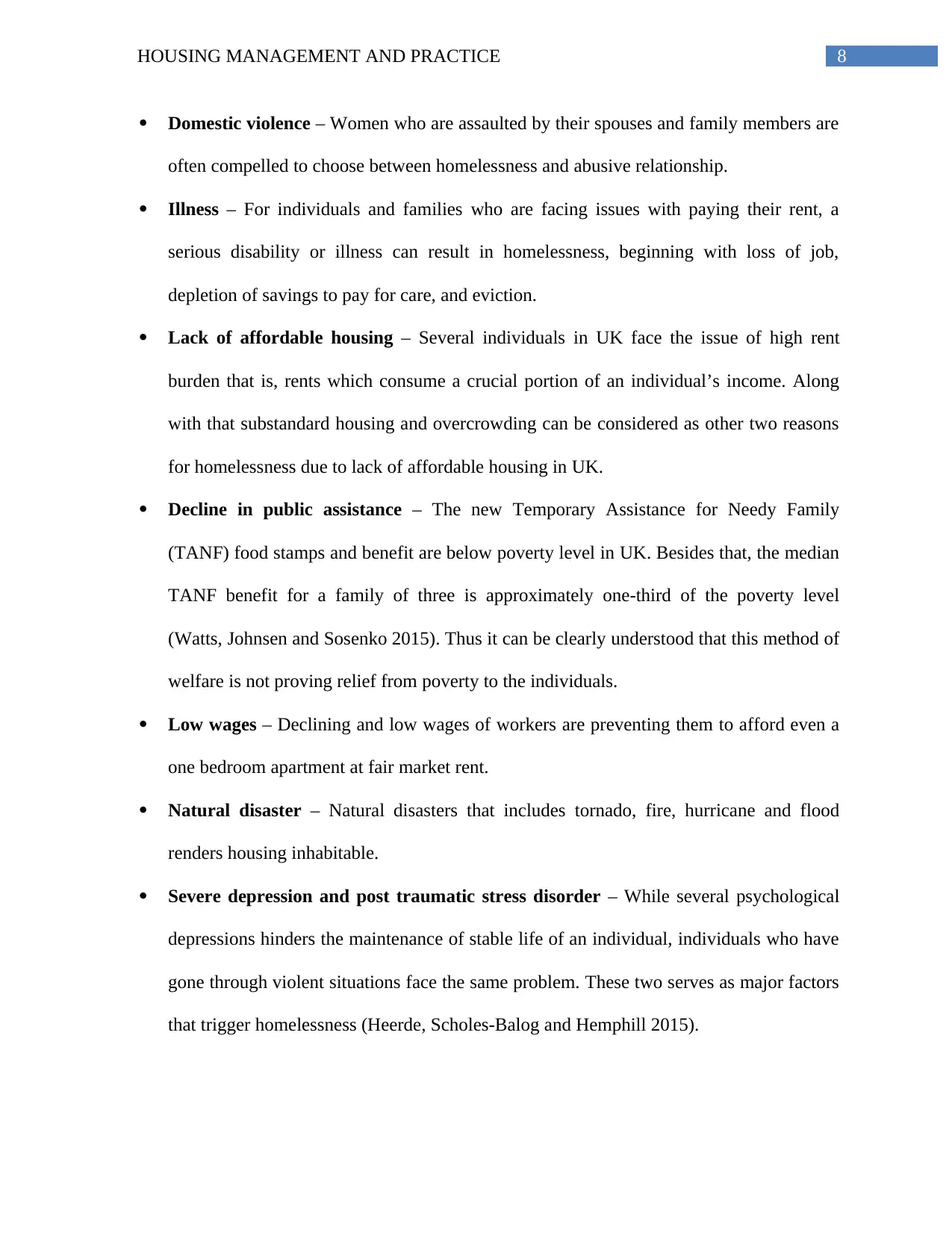
8HOUSING MANAGEMENT AND PRACTICE
Domestic violence – Women who are assaulted by their spouses and family members are
often compelled to choose between homelessness and abusive relationship.
Illness – For individuals and families who are facing issues with paying their rent, a
serious disability or illness can result in homelessness, beginning with loss of job,
depletion of savings to pay for care, and eviction.
Lack of affordable housing – Several individuals in UK face the issue of high rent
burden that is, rents which consume a crucial portion of an individual’s income. Along
with that substandard housing and overcrowding can be considered as other two reasons
for homelessness due to lack of affordable housing in UK.
Decline in public assistance – The new Temporary Assistance for Needy Family
(TANF) food stamps and benefit are below poverty level in UK. Besides that, the median
TANF benefit for a family of three is approximately one-third of the poverty level
(Watts, Johnsen and Sosenko 2015). Thus it can be clearly understood that this method of
welfare is not proving relief from poverty to the individuals.
Low wages – Declining and low wages of workers are preventing them to afford even a
one bedroom apartment at fair market rent.
Natural disaster – Natural disasters that includes tornado, fire, hurricane and flood
renders housing inhabitable.
Severe depression and post traumatic stress disorder – While several psychological
depressions hinders the maintenance of stable life of an individual, individuals who have
gone through violent situations face the same problem. These two serves as major factors
that trigger homelessness (Heerde, Scholes-Balog and Hemphill 2015).
Domestic violence – Women who are assaulted by their spouses and family members are
often compelled to choose between homelessness and abusive relationship.
Illness – For individuals and families who are facing issues with paying their rent, a
serious disability or illness can result in homelessness, beginning with loss of job,
depletion of savings to pay for care, and eviction.
Lack of affordable housing – Several individuals in UK face the issue of high rent
burden that is, rents which consume a crucial portion of an individual’s income. Along
with that substandard housing and overcrowding can be considered as other two reasons
for homelessness due to lack of affordable housing in UK.
Decline in public assistance – The new Temporary Assistance for Needy Family
(TANF) food stamps and benefit are below poverty level in UK. Besides that, the median
TANF benefit for a family of three is approximately one-third of the poverty level
(Watts, Johnsen and Sosenko 2015). Thus it can be clearly understood that this method of
welfare is not proving relief from poverty to the individuals.
Low wages – Declining and low wages of workers are preventing them to afford even a
one bedroom apartment at fair market rent.
Natural disaster – Natural disasters that includes tornado, fire, hurricane and flood
renders housing inhabitable.
Severe depression and post traumatic stress disorder – While several psychological
depressions hinders the maintenance of stable life of an individual, individuals who have
gone through violent situations face the same problem. These two serves as major factors
that trigger homelessness (Heerde, Scholes-Balog and Hemphill 2015).
⊘ This is a preview!⊘
Do you want full access?
Subscribe today to unlock all pages.

Trusted by 1+ million students worldwide
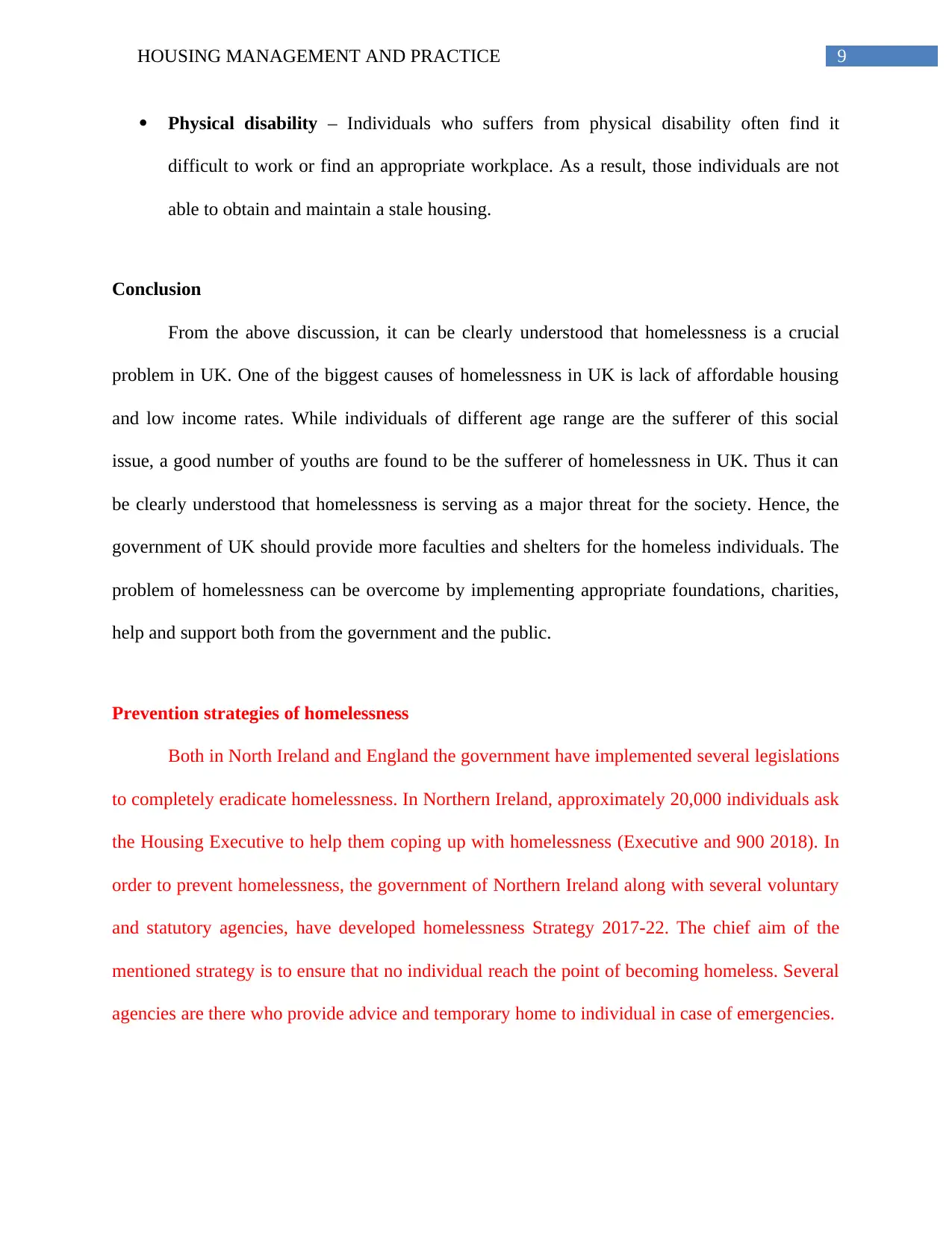
9HOUSING MANAGEMENT AND PRACTICE
Physical disability – Individuals who suffers from physical disability often find it
difficult to work or find an appropriate workplace. As a result, those individuals are not
able to obtain and maintain a stale housing.
Conclusion
From the above discussion, it can be clearly understood that homelessness is a crucial
problem in UK. One of the biggest causes of homelessness in UK is lack of affordable housing
and low income rates. While individuals of different age range are the sufferer of this social
issue, a good number of youths are found to be the sufferer of homelessness in UK. Thus it can
be clearly understood that homelessness is serving as a major threat for the society. Hence, the
government of UK should provide more faculties and shelters for the homeless individuals. The
problem of homelessness can be overcome by implementing appropriate foundations, charities,
help and support both from the government and the public.
Prevention strategies of homelessness
Both in North Ireland and England the government have implemented several legislations
to completely eradicate homelessness. In Northern Ireland, approximately 20,000 individuals ask
the Housing Executive to help them coping up with homelessness (Executive and 900 2018). In
order to prevent homelessness, the government of Northern Ireland along with several voluntary
and statutory agencies, have developed homelessness Strategy 2017-22. The chief aim of the
mentioned strategy is to ensure that no individual reach the point of becoming homeless. Several
agencies are there who provide advice and temporary home to individual in case of emergencies.
Physical disability – Individuals who suffers from physical disability often find it
difficult to work or find an appropriate workplace. As a result, those individuals are not
able to obtain and maintain a stale housing.
Conclusion
From the above discussion, it can be clearly understood that homelessness is a crucial
problem in UK. One of the biggest causes of homelessness in UK is lack of affordable housing
and low income rates. While individuals of different age range are the sufferer of this social
issue, a good number of youths are found to be the sufferer of homelessness in UK. Thus it can
be clearly understood that homelessness is serving as a major threat for the society. Hence, the
government of UK should provide more faculties and shelters for the homeless individuals. The
problem of homelessness can be overcome by implementing appropriate foundations, charities,
help and support both from the government and the public.
Prevention strategies of homelessness
Both in North Ireland and England the government have implemented several legislations
to completely eradicate homelessness. In Northern Ireland, approximately 20,000 individuals ask
the Housing Executive to help them coping up with homelessness (Executive and 900 2018). In
order to prevent homelessness, the government of Northern Ireland along with several voluntary
and statutory agencies, have developed homelessness Strategy 2017-22. The chief aim of the
mentioned strategy is to ensure that no individual reach the point of becoming homeless. Several
agencies are there who provide advice and temporary home to individual in case of emergencies.
Paraphrase This Document
Need a fresh take? Get an instant paraphrase of this document with our AI Paraphraser
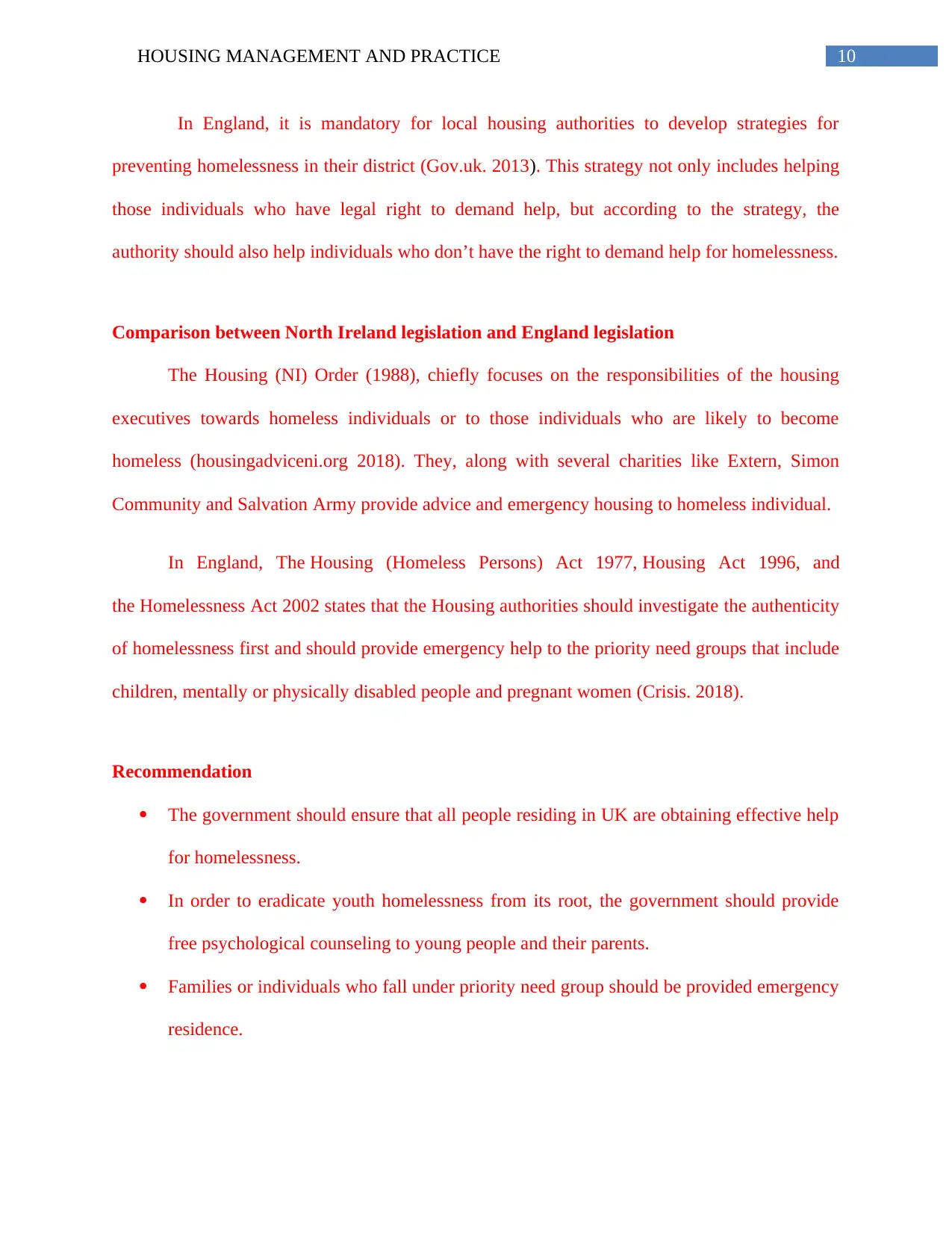
10HOUSING MANAGEMENT AND PRACTICE
In England, it is mandatory for local housing authorities to develop strategies for
preventing homelessness in their district (Gov.uk. 2013). This strategy not only includes helping
those individuals who have legal right to demand help, but according to the strategy, the
authority should also help individuals who don’t have the right to demand help for homelessness.
Comparison between North Ireland legislation and England legislation
The Housing (NI) Order (1988), chiefly focuses on the responsibilities of the housing
executives towards homeless individuals or to those individuals who are likely to become
homeless (housingadviceni.org 2018). They, along with several charities like Extern, Simon
Community and Salvation Army provide advice and emergency housing to homeless individual.
In England, The Housing (Homeless Persons) Act 1977, Housing Act 1996, and
the Homelessness Act 2002 states that the Housing authorities should investigate the authenticity
of homelessness first and should provide emergency help to the priority need groups that include
children, mentally or physically disabled people and pregnant women (Crisis. 2018).
Recommendation
The government should ensure that all people residing in UK are obtaining effective help
for homelessness.
In order to eradicate youth homelessness from its root, the government should provide
free psychological counseling to young people and their parents.
Families or individuals who fall under priority need group should be provided emergency
residence.
In England, it is mandatory for local housing authorities to develop strategies for
preventing homelessness in their district (Gov.uk. 2013). This strategy not only includes helping
those individuals who have legal right to demand help, but according to the strategy, the
authority should also help individuals who don’t have the right to demand help for homelessness.
Comparison between North Ireland legislation and England legislation
The Housing (NI) Order (1988), chiefly focuses on the responsibilities of the housing
executives towards homeless individuals or to those individuals who are likely to become
homeless (housingadviceni.org 2018). They, along with several charities like Extern, Simon
Community and Salvation Army provide advice and emergency housing to homeless individual.
In England, The Housing (Homeless Persons) Act 1977, Housing Act 1996, and
the Homelessness Act 2002 states that the Housing authorities should investigate the authenticity
of homelessness first and should provide emergency help to the priority need groups that include
children, mentally or physically disabled people and pregnant women (Crisis. 2018).
Recommendation
The government should ensure that all people residing in UK are obtaining effective help
for homelessness.
In order to eradicate youth homelessness from its root, the government should provide
free psychological counseling to young people and their parents.
Families or individuals who fall under priority need group should be provided emergency
residence.
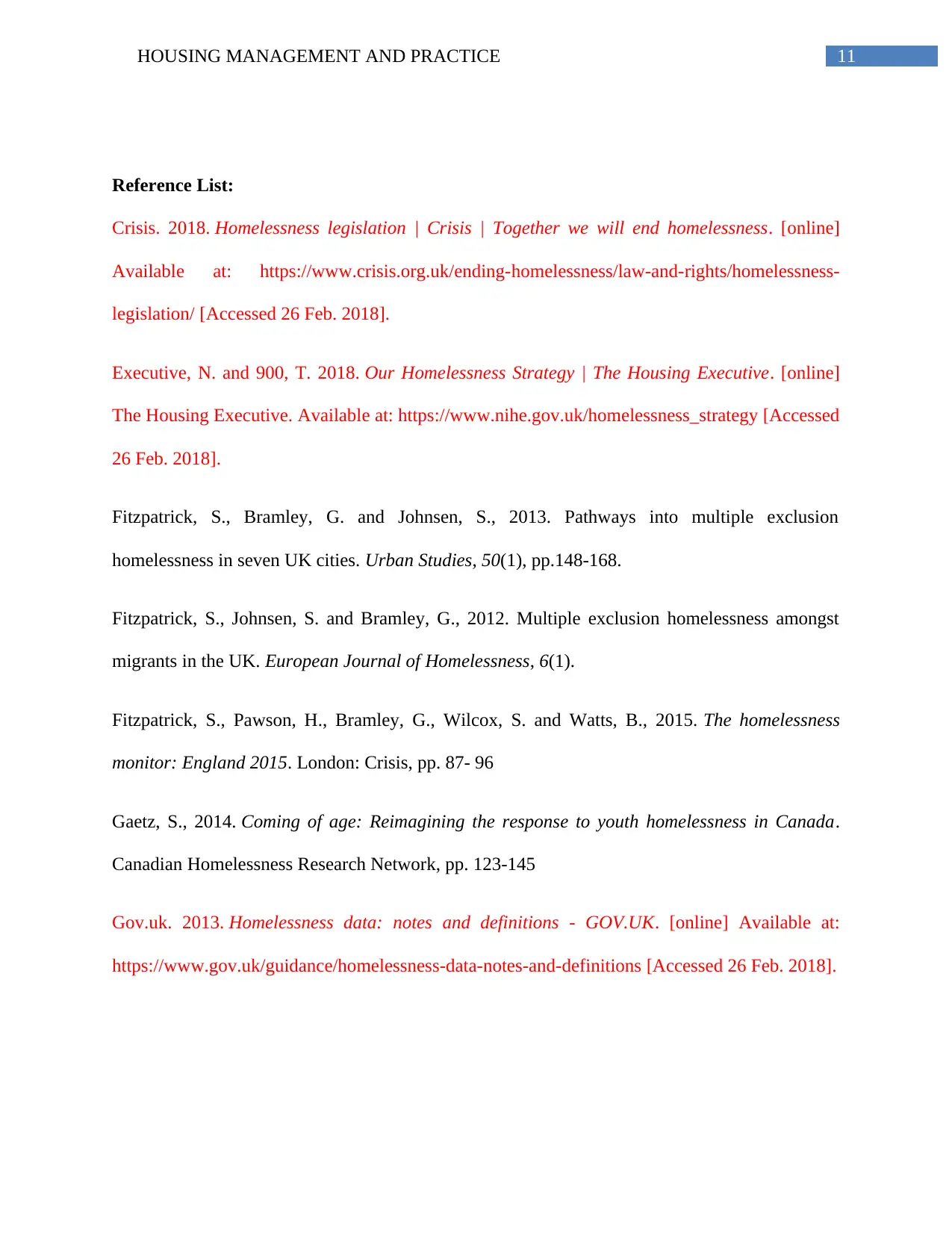
11HOUSING MANAGEMENT AND PRACTICE
Reference List:
Crisis. 2018. Homelessness legislation | Crisis | Together we will end homelessness. [online]
Available at: https://www.crisis.org.uk/ending-homelessness/law-and-rights/homelessness-
legislation/ [Accessed 26 Feb. 2018].
Executive, N. and 900, T. 2018. Our Homelessness Strategy | The Housing Executive. [online]
The Housing Executive. Available at: https://www.nihe.gov.uk/homelessness_strategy [Accessed
26 Feb. 2018].
Fitzpatrick, S., Bramley, G. and Johnsen, S., 2013. Pathways into multiple exclusion
homelessness in seven UK cities. Urban Studies, 50(1), pp.148-168.
Fitzpatrick, S., Johnsen, S. and Bramley, G., 2012. Multiple exclusion homelessness amongst
migrants in the UK. European Journal of Homelessness, 6(1).
Fitzpatrick, S., Pawson, H., Bramley, G., Wilcox, S. and Watts, B., 2015. The homelessness
monitor: England 2015. London: Crisis, pp. 87- 96
Gaetz, S., 2014. Coming of age: Reimagining the response to youth homelessness in Canada.
Canadian Homelessness Research Network, pp. 123-145
Gov.uk. 2013. Homelessness data: notes and definitions - GOV.UK. [online] Available at:
https://www.gov.uk/guidance/homelessness-data-notes-and-definitions [Accessed 26 Feb. 2018].
Reference List:
Crisis. 2018. Homelessness legislation | Crisis | Together we will end homelessness. [online]
Available at: https://www.crisis.org.uk/ending-homelessness/law-and-rights/homelessness-
legislation/ [Accessed 26 Feb. 2018].
Executive, N. and 900, T. 2018. Our Homelessness Strategy | The Housing Executive. [online]
The Housing Executive. Available at: https://www.nihe.gov.uk/homelessness_strategy [Accessed
26 Feb. 2018].
Fitzpatrick, S., Bramley, G. and Johnsen, S., 2013. Pathways into multiple exclusion
homelessness in seven UK cities. Urban Studies, 50(1), pp.148-168.
Fitzpatrick, S., Johnsen, S. and Bramley, G., 2012. Multiple exclusion homelessness amongst
migrants in the UK. European Journal of Homelessness, 6(1).
Fitzpatrick, S., Pawson, H., Bramley, G., Wilcox, S. and Watts, B., 2015. The homelessness
monitor: England 2015. London: Crisis, pp. 87- 96
Gaetz, S., 2014. Coming of age: Reimagining the response to youth homelessness in Canada.
Canadian Homelessness Research Network, pp. 123-145
Gov.uk. 2013. Homelessness data: notes and definitions - GOV.UK. [online] Available at:
https://www.gov.uk/guidance/homelessness-data-notes-and-definitions [Accessed 26 Feb. 2018].
⊘ This is a preview!⊘
Do you want full access?
Subscribe today to unlock all pages.

Trusted by 1+ million students worldwide
1 out of 13
Related Documents
Your All-in-One AI-Powered Toolkit for Academic Success.
+13062052269
info@desklib.com
Available 24*7 on WhatsApp / Email
![[object Object]](/_next/static/media/star-bottom.7253800d.svg)
Unlock your academic potential
Copyright © 2020–2025 A2Z Services. All Rights Reserved. Developed and managed by ZUCOL.





